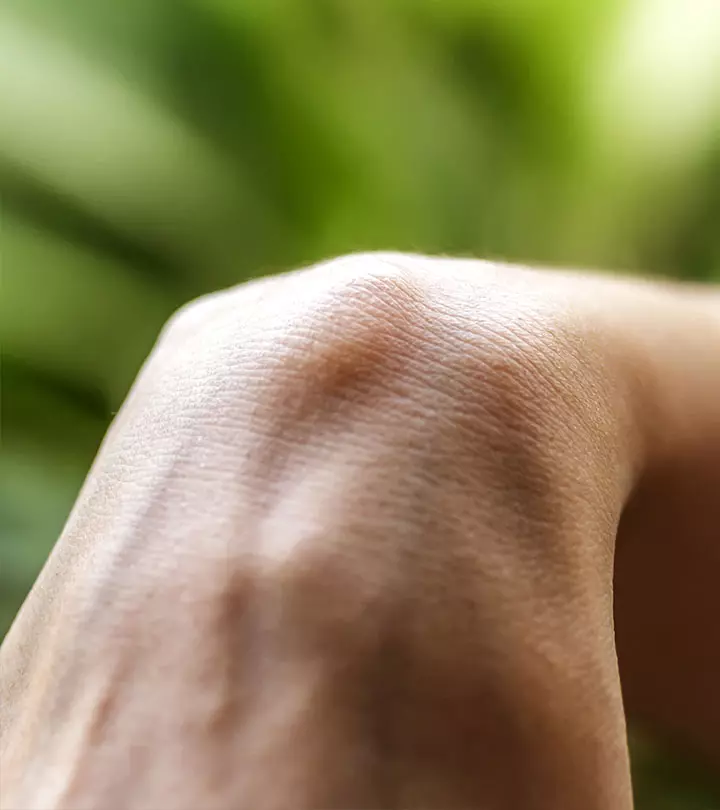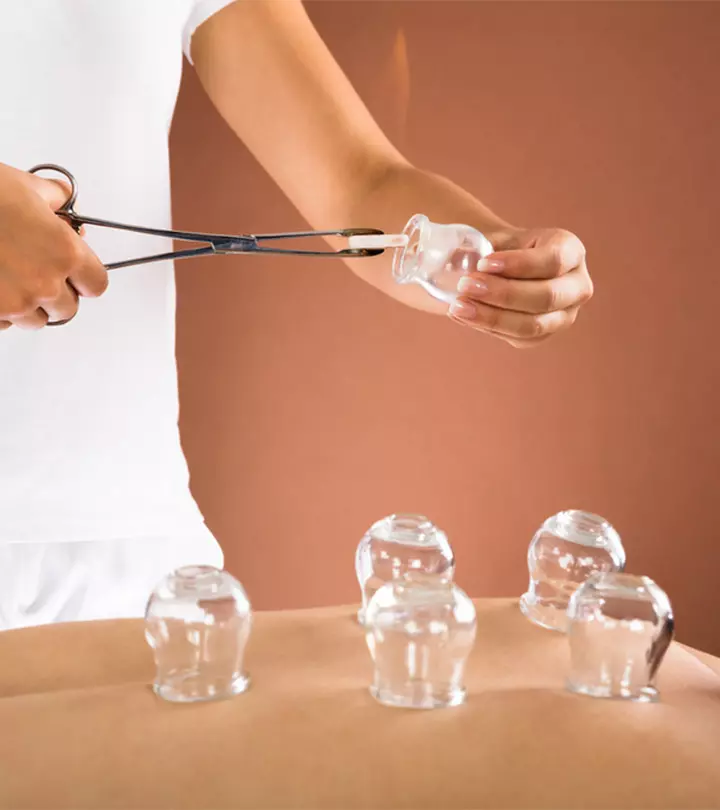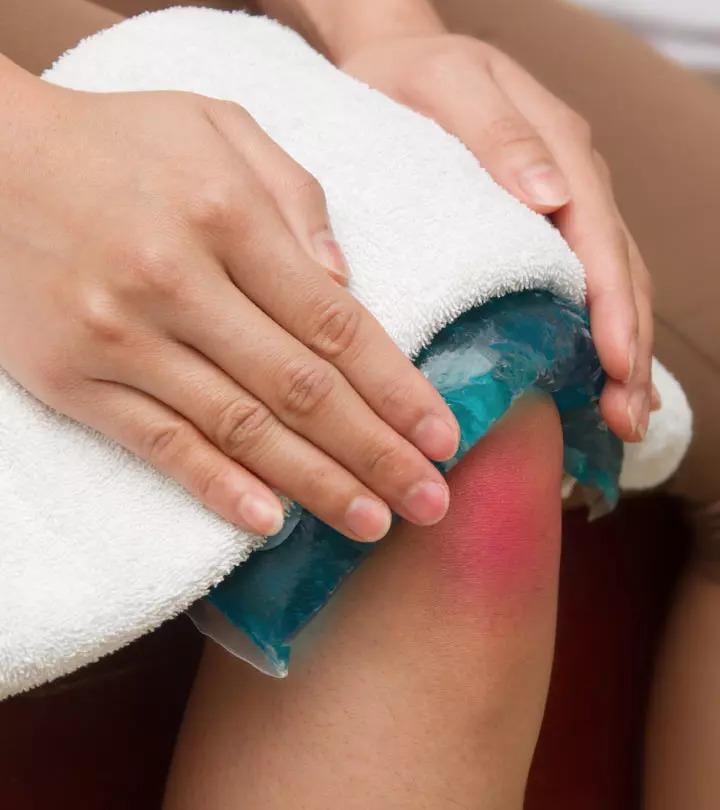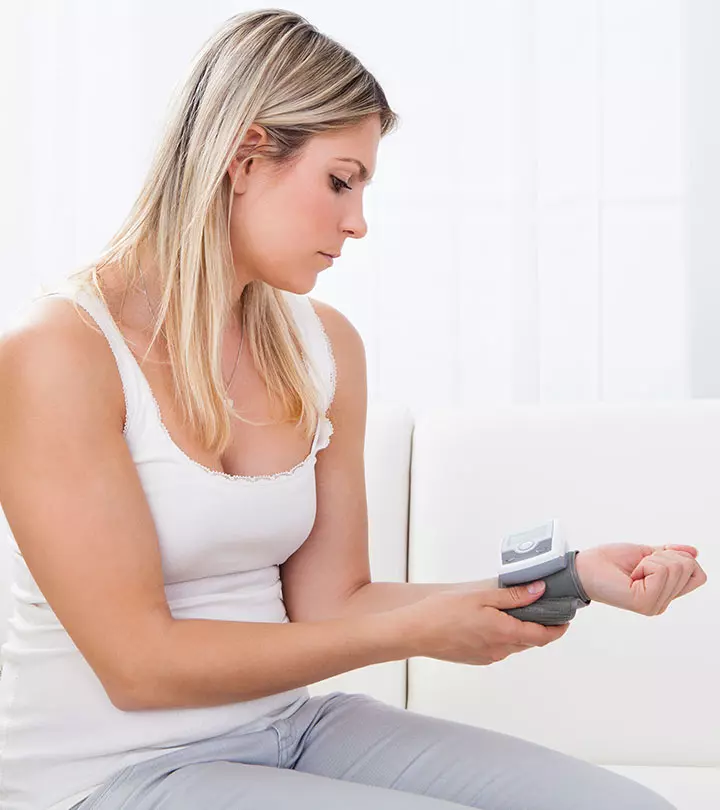Do Home Remedies For Carpal Tunnel Really Have Any Effect?
Explore the ways to manage this condition and improve your quality of life.

Image: Shutterstock
Carpal tunnel syndrome, a nerve condition, may often cause numbness, pain, and tingling sensations in hands and fingers. You may try the home remedies for carpal tunnel syndrome discussed in the article to relieve the symptoms. These remedies may help minimize the pain and uncomfortable sensations up to a certain extent. They may also help strengthen the hands and relieve pressure. You may consult a doctor and try them along with medications. Keep reading to learn more about them.
In This Article
Carpal Tunnel Syndrome: What Is It?
Carpal tunnel syndrome or CTS is a type of medical condition in which the median nerve gets pinched or compressed at the wrist. The median nerve is one of the three major nerves that run through your upper limbs. When this nerve gets pinched or compressed while passing through a narrow space called the carpal tunnel in your wrist, you get carpal tunnel syndrome.
It most commonly affects the hands or the wrist, but your elbow or shoulder region may be affected by carpal tunnel syndrome as well. The tendons that affect the movement of the thumb and the first three fingers also pass through the carpal tunnel, so compression in the median affects them as well. It has a few commonly reported symptoms as listed below (1).
- pain in the hand or wrist
- numbness
- a tingling sensation
- reduced grip strength and hand functionality
A pre-existing medical condition like hypothyroidism, rheumatoid arthritis, and diabetes may put you at a higher risk of developing carpal tunnel syndrome. Repetitive hand movements may also lead to carpal tunnel syndrome (1). The symptoms of carpal tunnel syndrome usually occur in the hands and fingers. If you experience symptoms like pain and tingling in the hands and feet, it is better to consult a doctor to prevent the risk of any underlying health concerns.
A study states that carpal tunnel syndrome (CTS) affects 1-5% of the general population, with a higher prevalence in females (3:1 female-to-male ratio). Obesity doubles the risk of developing CTS. Typically, CTS manifests in adults aged 40 to 60, and it’s uncommon in children.
“It’s also important that you rule out neck problems if you have symptoms of carpal tunnel syndrome,” states Dr. Dave Candy, physical therapist. He further adds, “Some neck-related disorders such as pinched C6 or C7 nerve root can cause symptoms of carpal tunnel syndrome. It’s important to see a healthcare professional to make sure you get a proper diagnosis.”
Check out the following section to unravel what factors may cause this syndrome.
Key Takeaways
- Carpal tunnel syndrome is a nerve condition in which the median nerve gets compressed.
- This condition may often cause numbness and a tingling sensation in the hands and fingers.
- Wearing wrist splints or braces and doing nerve gliding exercises and some gentle stretches with yoga may improve this condition.
- Carpal tunnel can be effectively managed with non-surgical treatments in most cases.
Causes Of Carpal Tunnel Syndrome
Carpal Tunnel Syndrome (CTS) mainly occurs when the median nerve in the wrist’s narrow carpal tunnel gets compressed. Here are some causes behind that.
- Poor ergonomics at the workplace that leads to improper positioning of hands and wrists while performing tasks.
- Prolonged exposure to vibrating tools or machinery.
- Prolonged, forceful, or awkward hand positions.
- Dislocation or instability of the nearby joints.
- Wrist injuries or trauma, such as fractures and sprains.
- Metabolic disorders such as high blood pressure or elevated levels of certain lipids.
- Hormonal changes, pregnancy, and obesity.
- Genetic predisposition and certain anatomical factors such as a smaller carpal tunnel.
Note: Carpal tunnel syndrome is sometimes confused with cubital tunnel syndrome. While both these conditions impact your hands and wrist, they affect different nerves. The former impacts the median nerve (runs from the armpit down the arm), while the latter impacts the ulnar nerve (runs down the front of the upper arm).
Understanding these causes can help prevent and manage Carpal Tunnel Syndrome effectively. Now that we know what carpal tunnel syndrome is and what leads to it, let’s see what home remedies for carpal tunnel can bring you relief.
Home Remedies For Carpal Tunnel Relief
There are certain things you can do at home for carpal tunnel pain relief. Generally, the sooner you are aware of how to help carpal tunnel, the better the chances of recovery.
- Wear Wrist Splints Or Braces
Wrist splints or braces are commonly recommended by doctors as a carpal tunnel remedy for mild to moderate cases. It can help to hold your wrists in a neutral position and provide relief as well as keep the symptoms from worsening. You can wear braces to bed as that would prevent you from bending your wrist in your sleep. In case you engage in daily activities that flare up your triggers, you can wear it during the daytime as well. It generally takes between 3 to 4 weeks for the symptoms to improve (2).
 Did You Know?
Did You Know?- Do Nerve Gliding Exercises
The evidence on the effectiveness of nerve gliding exercises is a little unclear due to the lack of quality trials and studies. However, a research review suggests that there is a positive trend between symptomatic carpal tunnel relief and nerve gliding exercises (3). There are various nerve gliding exercises you can do if you want to treat carpal tunnel at home. Here’s one that you can practice.
- Keep your wrist in a neutral position and make a relaxed fist with the back of your thumb facing you.
- Open your fist and extend your fingers and thumbs forward while maintaining a neutral position for your wrist.
- Keep your fingers and thumbs straight and turn your wrist so that your palm faces upwards.
- Hold your hand in the same position and extend your thumb outwards and away from your hand.
- Now, keeping your fingers as they are, turn your palm so that it faces away from you.
- With your free hand, gently tug at the thumb to pull it down.
- Hold each of these positions for 5 seconds and repeat all the steps between 3 and 5 times.
- Be Aware Of Your Posture
When you bend your shoulders forward too much, you can trigger a chain reaction to worsen your carpal tunnel syndrome. A 2009 study found that carpal tunnel syndrome was correlated with having a forward head posture and decreased neck range of motion (4). Although a cause-effect relationship can’t be drawn from this study, maintaining a proper posture or improving your posture is a good thing to do in general, and it might even help relieve symptoms of carpal tunnel syndrome.
There is some evidence to suggest that keeping your wrists in non-neutral positions for prolonged periods may increase the risk as well as the severity of carpal tunnel syndrome (5). So, try to ensure that you are holding your wrist in the neutral position as much as possible.
- Get Some Gentle Stretches With Yoga
There is some research-based evidence to suggest that yoga may help to ease the pain associated with carpal tunnel syndrome and improve grip strength. Yoga postures that help to mobilize the shoulders, neck, hands, and wrist may be beneficial. The gentle stretching that you get with yoga may help to relieve the compression on the carpal tunnel. It may also improve blood flow and joint posture, both of which can have a positive effect on carpal tunnel treatment (6).
- Apply Topical Pain Relief Gels/Creams On Affected Area
In a study on workers with carpal tunnel syndrome, researchers found that the application of topical menthol could significantly lower the pain during the workday (7). There is evidence from another study suggesting that flaxseed oil-based topical gels can also significantly reduce pain and make the symptoms manageable (8). So you slather on either a menthol-based or a flaxseed-based pain relief gel when your triggers flare up and cause you pain.
- Use A Low-level Heat Wrap
Research has found that a low-level heat wrap is effective in reducing pain quickly, and improving grip and function when used as a home remedy for carpal tunnel (9). To make a heat wrap at home, follow these steps:
- Fill an old, but clean sock with rice or oatmeal.
- Sew or tie it up.
- Pop the filled sock in the microwave and heat it for 1-2 minutes.
- Before you wrap it around your wrist or affected area, make sure the heat is bearable for you.
- Keep the heat wrap on as long as you feel comfortable.
 Pro Tip
Pro TipSometimes, even if you know how to treat carpal tunnel at home, you may have to resort to medication. Let’s see what over-the-counter medicine you can take to help you alleviate the symptoms of carpal tunnel syndrome.
Over-The-Counter Medications To Help Carpal Tunnel Symptoms
Aspirin, ibuprofen, or naproxen are the most common non-prescription medications that you can get from a pharmacy for treating carpal tunnel syndrome at home. These generally provide temporary relief and long-term or repeated use is not recommended (1). It is also important to be cautious about using aspirin if you take any blood thinner as a prescription drug (10).
Carpal tunnel may lead to complications, so it is important to know when to stop trying to treat it on your own and consult a medical professional.
When To See The Doctor
Home remedies for carpal tunnel may not be effective for all. If you have tried these home remedies and are finding your symptoms worsening or not improving within one or two weeks, you should seek medical help. You may visit your general physician or directly make an appointment with an orthopedic doctor who specializes in the treatment of joints, bones, and muscles.
Diagnosis Of Carpal Tunnel Syndrome
When you visit the doctor, you may be asked a list of questions to determine whether or not you have the symptoms of carpal tunnel syndrome. This step is followed up with a decision tree which helps to identify whether further investigation is required or not (1).
The doctor may also conduct a physical examination which includes the flick sign, Phalen test, and median nerve compression test. In certain irregular cases, you may be asked to undergo ultrasonography or electrodiagnostic studies to rule out other possible causes for your symptoms (11).
You may be wondering whether the doctor will recommend surgery or not in case you do have carpal tunnel syndrome. Let’s see if the carpal tunnel can be treated without surgical intervention.
Does Carpal Tunnel Go Away Without Surgery?
Mild to moderate cases of carpal tunnel may be effectively managed with non-surgical treatments that include splints and corticosteroid injections. Surgery is only recommended by doctors when such therapies are unsuccessful even after six months or when it is a case of severe carpal tunnel syndrome (11).
Darrel Allen, a registered nurse and guitarist as well as YouTuber, shared his experience about dealing with carpal tunnel syndrome in his video. He said, “In my job of course, it’s so important if you’re handing instruments to a surgeon during a surgery that you have to have that tactile sensation and the final straw for me was I was getting ready to hand an instrument to the surgeon and as my hand reached his hand, I realized that there was nothing in my hand. And I looked down and I had dropped an instrument and didn’t even feel it leave my hand (i).” After undergoing a surgery, he added, “It’s amazing, the results for me were immediate. The very first night after surgery I had an entire night’s sleep for the first time in probably six months, that I had a full night’s sleep without waking up and having my hand throbbing. So it’s pretty dramatic.”
Like all other conditions, when it comes to carpal tunnel syndrome, prevention is always better than cure. Scroll down for some effective strategies that can help prevent the risk of the condition.
Prevention Strategies For Carpal Tunnel Syndrome
Preventing carpal tunnel syndrome is within your reach. The best strategy is to reduce strain on the wrists and hands. Here are some simple and effective tips you can follow:
- Optimize your workspace to support a neutral wrist position. You can use an ergonomic keyboard with a wristrest and a mouse designed to minimize strain.
- Adjust your chair height and desk level to ensure your arms are at a comfortable angle and there is no pressure on the wrists.
- Sit with your back straight and shoulders relaxed to minimize strain on your wrists and hands.
- When you’re engaged in a repetitive task, it’s important to take short breaks every 20–30 minutes. This allows your hands to rest and your wrists to stretch, preventing strain and reducing the risk of carpal tunnel syndrome.
- Perform simple wrist and hand stretches to enhance flexibility. You can also try grip-strengthening and forearm exercises to improve muscle endurance and support.
- Maintaining a healthy weight is not just beneficial for overall health, but it also plays a significant role in reducing pressure on nerves and joints, including those in your wrists.
- Pay attention to early warning signs like tingling, numbness, or discomfort in your hands or wrists. Visit a doctor if you experience any of them to prevent the progression of the condition.
Carpal tunnel syndrome may cause pain and numbness in the hands and fingers. Constant typing or repeated hand movements along with certain predisposed medical conditions like rheumatoid arthritis or diabetes may result in this condition. While it is painful and may hamper your daily activities, it usually can get better without the need for any invasive surgery. Wrist braces, gentle stretches, work posture changes, and topical ointments can help manage the pain and discomfort of carpal tunnel syndrome better. In case the symptoms persist beyond 2 weeks or seem to be getting worse or unbearable, it is best to consult a doctor for the appropriate line of treatment.
Frequently Asked Questions
Is massage good for carpal tunnel?
Yes, massage is good for carpal tunnel. It relieves pain, inflammation, and numbness.
Does Epsom salt help carpal tunnel?
Yes. Epsom salt helps relieve the pain associated with carpal tunnel. Soaking the hands and wrists in warm water and Epsom salt for 15 minutes alleviates the pain and numbness.
Can turmeric help with carpal tunnel?
Yes. Turmeric helps relieve the pain and inflammation associated with carpal tunnel.
Carpal tunnel syndrome can cause pain and numbness in the wrist and further increase discomfort additional applied pressure. Watch the following video to get a better understanding of the symptoms and risk factors of CTS.
Personal Experience: Source
StyleCraze's articles are interwoven with authentic personal narratives that provide depth and resonance to our content. Below are the sources of the personal accounts referenced in this article.
(i) Carpal Tunnel Syndrome: Darrell’s storyhttps://www.youtube.com/watch?v=oEa5l0b0gfs
References
Articles on StyleCraze are backed by verified information from peer-reviewed and academic research papers, reputed organizations, research institutions, and medical associations to ensure accuracy and relevance. Read our editorial policy to learn more.
- Diagnosing and managing carpal tunnel syndrome in primary care
https://www.ncbi.nlm.nih.gov/labs/pmc/articles/PMC4001168/ - Efficacy of a soft hand brace and a wrist splint for carpal tunnel syndrome: a randomized controlled study
https://onlinelibrary.wiley.com/doi/10.1111/j.1600-0404.2008.01072.x - Effectiveness of Nerve Gliding Exercises on Carpal Tunnel Syndrome: A Systematic Review
https://pubmed.ncbi.nlm.nih.gov/27842937/ - Increased forward head posture and restricted cervical range of motion in patients with carpal tunnel syndrome
https://pubmed.ncbi.nlm.nih.gov/19721213/ - Meta-Analysis: Association Between Wrist Posture and Carpal Tunnel Syndrome Among Workers
https://www.sciencedirect.com/science/article/pii/S2093791114000043 - Yoga-Based Intervention for Carpal Tunnel Syndrome
https://jamanetwork.com/journals/jama/fullarticle/188150 - Acute Effect of Topical Menthol on Chronic Pain in Slaughterhouse Workers with Carpal Tunnel Syndrome: \’Triple-Blind\’ Randomized Placebo-Controlled Trial
https://www.hindawi.com/journals/rerp/2014/310913/ - A Topical Gel From Flax Seed Oil Compared With Hand Splint in Carpal Tunnel Syndrome: A Randomized Clinical Trial
https://journals.sagepub.com/doi/full/10.1177/2156587216677822 - Continuous low-level heat wrap therapy is effective for treating wrist pain
https://pubmed.ncbi.nlm.nih.gov/15375809/ - Association of Adding Aspirin to Warfarin Therapy Without an Apparent Indication With Bleeding and Other Adverse Events
https://jamanetwork.com/journals/jamainternalmedicine/fullarticle/2726050 - Carpal Tunnel Syndrome: Diagnosis and Management
https://pubmed.ncbi.nlm.nih.gov/28075090/
Read full bio of Dr. Dave Candy
Read full bio of Sanchari Bhattacharya
Read full bio of Arshiya Syeda
Read full bio of Dipti Sharma




























Community Experiences
Join the conversation and become a part of our empowering community! Share your stories, experiences, and insights to connect with other beauty, lifestyle, and health enthusiasts.